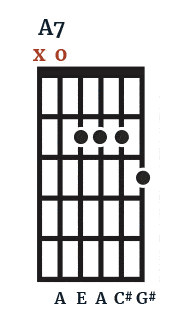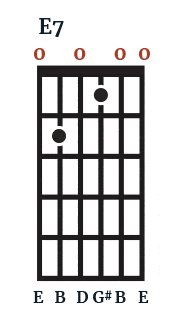Ever tried learning a new song, only to see a 7 written beside a chord that you would otherwise have known how to play? While there are 4 other (common types) of 7th chords, in most cases, the 7 refers to the chord being a dominant 7th chord, also written as dom7. In today’s article, we’re going to discuss dominant 7th chords, what they are, how they are built, why they sound bluesy (in the correct context), and how you can incorporate them into your playing.
But if looking for a quick summary of Dominant 7th Chords: A dominant 7th chord is a chord with the same structure as a major triad (1st, 3rd, and 5th scale degrees of the major scale) along with a flattened 7th scale degree. While around longer than blues music, dominant 7th chords are synonymous with blues, due to the interplay between major and minor which creates tension/dissonance.
The interval between the 3rd and 7th also happens to be a tritone (aka the devil’s interval, a particularly dissonant sounding interval comprised of 6 semitones), combined with the minor 7th, gives dominant 7th chords that bluesy sound.
What do Dominant 7th Chords Sound Like?
Here’s a quick audio clip demonstrating an A Major triad in open position followed by an A Dominant 7th chord, also in open position.
As you can hear, the combination of Major and minor gives the chord added dissonance making it sound bluesy and really pulling us toward the tonic chord to resolve.
Click here to compare the sound of a dominant 7th chord to that of a major 7th chord, which only differs by one semitone e.g. the minor 7th interval is replaced with a Major 7th.
How are dominant 7th chords built?
Dominant 7th chords consist of a root, major third, perfect fifth, and a minor seventh, which is an interval of 10 semitones above the root note. If you aren’t familiar with guitar theory or intervals you can read more here.

Based on this, the notes that make up an A7 chord are A, C♯, E, and G
| Intervals | P1 | m2 | M2 | m3 | M3 | p4 | A4 | P5 | m6 | M6 | m7 | M7 | P8 |
| Semitones | 0 | 1 | 2 | 3 | 4 | 5 | 6 | 7 | 8 | 9 | 10 | 11 | 12 |
| Notes | A | A♯ | B | C | C♯ | D | D♯ | E | F | F♯ | G | G♯ | A |
The easiest way to think of this is that 7th chords are major chords with an added note 10 semitones above the root, or two semitones (a whole tone) below the root, played in a higher octave.
In case unfamiliar with the shorthand used for naming intervals. P is short for Perfect e.g. P5 is an interval of a perfect 5th (7 semitones above the root), while the small ‘m’ indicates a minor interval e.g. m7 is a minor 7th interval (10 semitones) while an M7 is a major 7th interval (11 semitones).
If referring to dominant 7th chords by scale degrees our formula would include the 1, 3, 5, and 7th note of the major scale, however, the 7th scale degree is flattened by a semitone (1 – 3 – 5 – b7) making it a minor 7th interval.
A Major
| 1 | 2 | 3 | 4 | 5 | 6 | b7 |
| A | B | C♯ | D | E | F♯ | G |
Why is it named a ‘dominant’ seventh chord?
Dominant 7th chords are usually built on the 5th scale degree of a particular key. As a result, you also see them referred to as V7 e.g. the V chord in the key of A is E, and E Major in this context can be substituted with an E dom 7 chords.
I – A major, A major seventh (Amaj, Amaj7)
ii – B minor, B minor seventh (Bm, Bm7)
iii – C sharp minor, C# minor seventh (C#m, C#m7)
IV – D major, D major seventh (D, Dmaj 7)
V – E major, E dominant seventh (E, E7)
vi – F sharp minor, F# minor seventh (F#m, F#m7)
vii° – G# diminished, G# minor seventh flat five (G#°, G#m7b5)
Why is the 5th scale degree called ‘dominant’?
In a diatonic scale (a 7 note scale built on 5 whole steps and 2 half steps) each note is referred to as a scale degree, and each has a scale degree name that indicates its function.
For example, the mediant (Latin for ‘middle’), suggests the scale degree is near the middle of the scale.
| I | ii | iii | IV | V | vi | vii° |
| Tonic | Super Tonic | Mediant | Subdominant | Dominant | Submediant | Subtonic (minor), Leading Tone (Major) |
| Amaj | Bmin | C♯min | Dmaj | Emaj | F♯min | G♯dim |
You may have noticed this naming system more when referring to chords e.g. I, IV, V chord progressions. * Note the systems used capitals to indicate major chords and lower case to indicate minor chords.
The I chord is the tonic (1st chord), the IV chord is the subdominant, indicating the progression is moving away from the tonic while the V chord or dominant wants to resolve back to the tonic.
In the table above E is the 5th scale degree and therefore dominant. Don’t be fooled by the name however, dominant doesn’t mean it is the most important scale degree, it isn’t the scale degree or chord that dominates, it is however the next most important scale degree from the tonic (starting note).
Alternatively, going back to our A7 example., A7 would be dominant in the key of D.
D Major
| I | ii | iii | IV | V | vi | vii° |
| Tonic | Super Tonic | Mediant | Subdominant | Dominant | Submediant | Subtonic (minor), Leading Tone (Major) |
| Dmaj | Emin | F♯min | Gmaj | Amaj | Bmin | C♯dim |
How to play Dominant 7th chords on guitar
If you know your major scale, to play a dominant 7th chord, simply add a note two semitones (2 frets) lower than the root but in the next highest octave.
In the case of the A7 chord we’ve been using as an example, this would mean simply adding the G by fretting the high E string (6th string) at the 3rd fret, or removing the finger from the 2nd fret G string, so it plays as an open string substituting our second A for a G.

Below are voicings for the dominant 7th chords in open position. If you need to brush up on how to read chord charts, click here.







Why does the C7 chord feature a Bb and not an A#?
While you might see one or the other used interchangeably, enharmonic notes (sharps and flats) are musical equivalents (in most contexts). When referring to diatonic scales, each letter name is represented. So rather than repeating a note with a sharp or flat symbol, it’s more obvious to use the next letter in the sequence.
Incorrect (letter names are repeated): A, B, D♭, D, E, G♭, and G♯
Correct (letter names are not repeated) A, B, C♯, D, E, F♯, and G♯
So why would a C7 chord contain an A♭ and not a G♯? considering the C major scale has no sharps or flats? Remember earlier when we discussed dominant 7th chords as being the dominant chord e.g. built from the 5th scale degree. This means C7 is actually the dominant chord in the key of F. The F major scale contains the following notes:
F Major Scale: F, G, A, B♭, C, D, and E
You will also see an E♭included in our F7 chord as F is the dominant note of the B♭Major scale.
B♭ – C – D – E♭ –F – G – A – B♭
Don’t sweat it if you see chord charts online that use all sharps, it’s become more common when illustrating guitar chords.
How to Get Started with Dominant 7th chords
Once open chords are mastered, guitarists will usually expand their chord repertoire with more expansive chords, including sus chords and 7th chords. For the most part, these are fairly simple shapes to learn but applying them can be more difficult.
As discussed above, dominant 7th chords are usually played as a V chord in a chord progression, as a way to build tension before resolving to the tonic chord, but can also be used as a substitute for each chord of a 12 bar blues. So if playing in the key of E for example, instead of playing the I chord as E Major try substituting with an E dom 7 chord, likewise for the IV chord (A7) and V chord (B7).
Summary
Learning different chord types, including 7th and extended chords, allows you to incorporate elements such as dissonance and consonance (harmonic agreement) into your playing. This delicate balance between tension and release when used effectively makes music more engaging and compelling.
![Cowboy Chords [The Complete Guide] 11 Cowboy Chords](https://theacousticguitarist.com/wp-content/uploads/2021/05/cowboy-chords.jpg)
![7th Chords [Complete Guide] 12 What are 7th Chords](https://theacousticguitarist.com/wp-content/uploads/2021/09/what-are-7th-chords.gif)